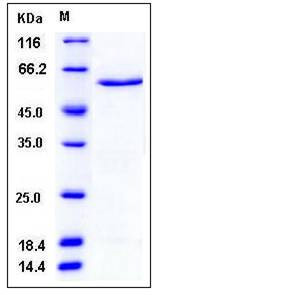Human CDK5 Protein (GST Tag)
PSSALRE
- 100ug (NPP3732) Please inquiry
| Catalog Number | P10897-H09B |
|---|---|
| Organism Species | Human |
| Host | Baculovirus-Insect Cells |
| Synonyms | PSSALRE |
| Molecular Weight | The recombinant human CDK5/GST chimera consists of 516 amino acids and has a predicted molecular mass of 59.6 kDa as estimated in SDS-PAGE under reducing conditions. |
| predicted N | Met |
| SDS-PAGE |  |
| Purity | > 94 % as determined by SDS-PAGE |
| Protein Construction | A DNA sequence encoding the human CDK5 isoform 1 (NP_004926.1) (Met 1-Pro 292) was fused with the GST tag at the N-terminus. |
| Bio-activity | No Kinase Activity |
| Research Area | Signaling |Signal Transduction |Metabolism |Types of disease |Metabolism in Obesity |
| Formulation | Lyophilized from sterile PBS, 0.5mM GSH, pH 7.0 1. Normally 5 % - 8 % trehalose, mannitol and 0.01% Tween80 are added as protectants before lyophilization. Specific concentrations are included in the hardcopy of COA. |
| Background | Cell division protein kinase 5, also known as Cyclin-dependent kinase 5, Serine/threonine-protein kinase PSSALRE, Tau protein kinase II catalytic subunit, TPKII catalytic subunit and CDK5, is a cytoplasm protein which belongs to the protein kinase superfamily, CMGC Ser/Thr protein kinase family and CDC2 / CDKX subfamily. Cyclin-dependent kinases (Cdks) are a family of proline-directed Ser/Thr kinases known for their role in the control of cell cycle progression. In 1992, this family was joined by CDK5, which is an atypical member in that it uses its own activators and is multifunctional, playing important regulatory roles in multiple cellular functions. CDK5, unlike other Cdks, is not regulated by cyclins, and its activity is primarily detected in postmitotic neurons in developing and adult nervous systems. CDK5 is activated by association with a neuron-specific activator, p35 or its isoform p39. CDK5 is probably involved in the control of the cell cycle. It interacts with D1 and D3-type G1 cyclins. CDK5 can phosphorylate histone H1, tau, MAP2 and NF-H and NF-M. It also interacts with p35 which activates the kinase. CDK5 plays important roles in various neuronal activities, including neuronal migration, synaptic activity, and neuronal cell death. |
| Reference |
